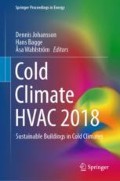Abstract
To achieve housing retrofit targets, traditional house-by-house approaches must scale. Neighbourhood retrofit also facilitates community participation. This paper aims to quantitatively characterise the heat energy demand of similar homes in a post-retrofit neighbourhood. The method employs the Modelica AixLib library, dedicated to building performance simulation. A modern semi-detached house is modelled as thermal network. The passive thermal network is calibrated against an equivalent EnergyPlus model. The developed Modelica model then generates time series heat energy demand to meet occupant comfort. This model separates heating for internal space and domestic hot water. Simulation results are gathered for a range of house occupancy profiles, with varying heating schedules and occupant quantities. The calibration results compare the time series of internal house temperature produced by the EnergyPlus and Modelica simulations. Modelica simulations of two heating schedules generate distinct annual demand curves against occupant quantity. As expected in a modern house, domestic hot water accounts for a relatively high proportion of heat energy. Over a year it ranges between 20 and 45% depending on occupant profile. Overall conclusions are threefold. Firstly, occupant profiles of a modern semi-detached house increase annual heat energy demand by 77%, and the coincidence of daily peak demand persists across occupant profiles. Furthermore, percentages of domestic hot water demand start from 20 or 24% and plateau at 39 or 45% depending on space heating schedule. A statistical distribution of energy demand by neighbourhood homes is possible. Its curve plot is not perfectly normal, skewing to larger energy demands.
Access this chapter
Tax calculation will be finalised at checkout
Purchases are for personal use only
References
N. Good, L. Zhang, A. Navarro-Espinosa, P. Mancarella, High resolution modelling of multi-energy domestic demand profiles. Appl. Energy 137, 193–210 (2015)
R. Gupta, M. Gregg, S. Passmore, G. Stevens, Intent and outcomes from the retrofit for the future programme: key lessons. Build. Res. Inf. 43, 435–451 (2015)
P. Jones, S. Lannon, J. Patterson, Retrofitting existing housing: how far, how much? Build. Res. Inf. 41, 532–550 (2013)
P. Moran, J. Goggins, M. Hajdukiewicz, Super-insulate or use renewable technology? Life cycle cost, energy and global warming potential analysis of nearly zero energy buildings (NZEB) in a temperate oceanic climate. Energy Build. 139, 590–607 (2017)
B.V. Mathiesen, D. Drysdale, H. Lund, S. Paardekooper, I. Ridjan, D. Connolly, J.S. Jensen, Future Green Buildings (Aalborg University, Department of Development and Planning, Aalborg, 2016)
A. Koch, S. Girard, K. McKoen, Towards a neighbourhood scale for low- or zero-carbon building projects. Build. Res. Inf. 40, 527–537 (2012)
O. Neu, B. Sherlock, S. Oxizidis, D. Flynn, D. Finn, Developing building archetypes for electrical load shifting assessment: analysis of Irish residential stock, in CIBSE ASHRAE Technical Symposium: Moving to a New World of Building Systems Performance, Dublin, Ireland (2014), pp. 1–19
M. Badurek, M. Hanratty, B. Sheldrick, D. Stewart, Building Typology Brochure Ireland (2014)
IEA Annex 60: Summary—IEA EBC Annex 60, http://www.iea-annex60.org/about.html
D. Müller, M. Lauster, A. Constantin, M. Fuchs, P. Remmen, AIXLIB—An open-source Modelica library within the IEA-EBC Annex 60 framework, in BauSIM (2016), pp. 3–6
M. Lauster, J. Teichmann, M. Fuchs, R. Streblow, D. Mueller, Low order thermal network models for dynamic simulations of buildings on city district scale. Build. Environ. 73, 223–231 (2014)
B.D.B. Crawley, L.K. Lawrie, EnergyPlus: energy simulation program. ASHRAE J. 42, 49–56 (2000)
D.B. Crawley, L.K. Lawrie, F.C. Winkelmann, W.F. Buhl, Y.J. Huang, C.O. Pedersen, R.K. Strand, R.J. Liesen, D.E. Fisher, M.J. Witte, J. Glazer, EnergyPlus: creating a new-generation building energy simulation program. Energy Build. 33, 319–331 (2001)
D. Connolly, H. Lund, B.V. Mathiesen, S. Werner, B. Möller, U. Persson, T. Boermans, D. Trier, P.A. Østergaard, S. Nielsen, Heat roadmap Europe: combining district heating with heat savings to decarbonise the EU energy system. Energy Policy 65, 475–489 (2014)
J. Egan, D. Finn, P.H. Deogene Soares, V.A. Rocha Baumann, R. Aghamolaei, P. Beagon, O. Neu, F. Pallonetto, J. O’Donnell, Definition of a useful minimal-set of accurately-specified input data for building energy performance simulation. Energy Build. 165, 172–183 (2018)
A. Garnier, J. Eynard, M. Caussanel, S. Grieu, Predictive control of multizone heating, ventilation and air-conditioning systems in non-residential buildings. Appl. Soft Comput. 37, 847–862 (2015)
A. Tindale, Third-order lumped-parameter simulation method. Build. Serv. Eng. Res. Technol. 14, 87–97 (1993)
NREL: Weather Data by Location EnergyPlus—Europe WMO Region 6, Ireland, https://energyplus.net/weather-location/europe_wmo_region_6/IRL//IRL_Dublin.039690_IWEC
L. Peeters, J. Van der Veken, H. Hens, L. Helsen, W. D’haeseleer, Control of heating systems in residential buildings: current practice. Energy Build. 40, 1446–1455 (2008)
SEAI: What are the electricity factors used in the latest version of DEAP?, http://www.seai.ie/Your_Building/BER/BER_FAQ/FAQ_DEAP/Results/What_are_the_electricity_factors_used_in_the_latest_version_of_DEAP.html
SEAI: Derivation of Primary Energy and CO2 Factors for Electricity in DEAP (2016)
J. Egan, The Definition and Application of a Useful Minimum Set of Accurately-Defined Data for Building Energy Performance Simulation (2015)
B. Coyne, S. Lyons, D. McCoy, The Effects of Home Energy Efficiency Upgrades on Social Housing Tenants: Evidence from Ireland (2016)
J. Salom, A.J. Marszal, J. Widén, J. Candanedo, K.B. Lindberg, Analysis of load match and grid interaction indicators in net zero energy buildings with simulated and monitored data. Appl. Energy 136, 119–131 (2014)
J.P. Waltz, Computerized Building Energy Simulation Handbook (Marcel Dekker, New York, 2000)
Acknowledgements
Paul Beagon gratefully acknowledges that his research is supported in part by a research grant from Science Foundation Ireland (SFI) under the SFI Strategic Partnership Programme Grant Number SFI/15/SPP/E3125.
Paul thanks Moritz Lauster of RWTH Aachen University and E. ON Energy Research Center, for his kind and useful advice on AixLib library.
Author information
Authors and Affiliations
Corresponding author
Editor information
Editors and Affiliations
Rights and permissions
Copyright information
© 2019 Springer Nature Switzerland AG
About this paper
Cite this paper
Beagon, P., Boland, F., O’Donnell, J. (2019). Operational Characterisation of Neighbourhood Heat Energy After Large-Scale Building Retrofit. In: Johansson, D., Bagge, H., Wahlström, Å. (eds) Cold Climate HVAC 2018. CCC 2018. Springer Proceedings in Energy. Springer, Cham. https://doi.org/10.1007/978-3-030-00662-4_19
Download citation
DOI: https://doi.org/10.1007/978-3-030-00662-4_19
Published:
Publisher Name: Springer, Cham
Print ISBN: 978-3-030-00661-7
Online ISBN: 978-3-030-00662-4
eBook Packages: EnergyEnergy (R0)

